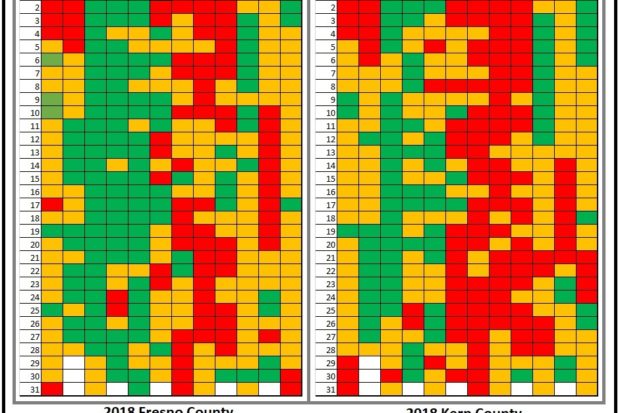
By Tom Frantz
The 2018 SJV State of the Air Report is not the American Lung Association annual report, which goes by a similar name. In that report, ozone and particulate pollution are separated and the entire country is evaluated. This report looks only at Fresno and Kern counties and combines several types of pollution.
Ozone and particulate matter are the most common air pollutants, but they affect our lungs and bodies in different ways. Both are dangerous. The most serious health effects are commonly associated with particulate matter, but heavy ozone pollution can be debilitating as well.
Some locations in the United States are bad for one kind of pollution but not necessarily the other. Pittsburgh, for example, has occasional high levels of particulate pollution but is hardly on the radar for ozone standard violations. Phoenix is the opposite with considerable ozone violations, associated with its warm climate, but few particulate issues. In contrast, the Bakersfield and Fresno areas are in the top five nationally for every type of pollution every year.
Take a look at the two charts accompanying this article for Fresno and Kern counties. They illustrate one important fact. Fresno and Kern have far more days in the year with significant air pollution than there are days when the entire population can enjoy themselves outside. Kings, Tulare and Madera counties could also be considered in the same leaky pollution boat, which is on fire at both ends.
Using colors in the charts similar to the air quality index, the days marked red are bad for everyone. It doesn’t matter if it is ozone or particulates, or both. It doesn’t matter how healthy you are; outdoor activity on those red days does health damage.
The days marked green are the opposite. Almost all residents on those days can go outside to exercise or sit in a chair on the porch and read a book.
The gold-colored days affect only half the population in a bad way. The so-called sensitive groups are about 50% of the total population. They include many groups of people who suffer with exposure to lower levels of pollution.
The young, who are still growing and still developing their lungs and brains, are damaged by these relatively low levels of air pollution with the effects often lasting a lifetime with decreased lung capacity and damaged organs. The chronically ill of any age also cannot tolerate even these lower levels of air pollution. Those with asthma, diabetes, heart problems or cancer suffer severe symptoms when the air is only marginally dirty.
Pregnant mothers and their unborn children will both suffer from low levels of pollution similar to when a pregnant mother is a smoker. People who work outside have increased exposure times and therefore low levels of pollution damage their bodies through attrition. The elderly among us, age 60 and up, have naturally decreased lung capacity and less resistance to the negative effects of pollution so they are also sensitive to relatively low levels of soot and smog.
Altogether, it should be clear that at least 50% of Valley residents are considered at risk to the lower levels of air pollution indicated by these gold squares. Of course, these sensitive groups also suffer the most during the red days.
In conclusion, around two-thirds of the days in Fresno County are unhealthy for at least half the population living there. The same applies to about three-fourths of the days in Kern County. Neither statistic should be acceptable to our political leaders. There is no other place in the United States even close to having this many unsafe days to breathe for so many people.
The California Air Resources Board recently approved a plan to clean up our fine particulate pollution on Jan. 24. (Actually, as of this writing, it is predicted the Board will do so.) It promises that by 2025 we will meet the tightest standards in the world for this type of pollution.
But there is a major problem. This new plan relies on at least $5 billion in state funding, mostly to give away to truckers and farmers to help them purchase cleaner engines. Nothing close to that amount is actually available and certainly has never been spent in the past.
We currently are sitting on 10 years of virtually no improvement for particulate levels in the southern half of the Valley. This is despite the air district giving away around $130 million per year as incentives. They have little to show for these past expenditures. Now we are expected to believe $1 billion will suddenly be available per year for the next five years and that this money will solve everything.
Some people might get rich from this humongous proposed giveaway. Let’s hope it helps the local economy. But without firm backstops to force action on a massive scale, this money might be wasted in terms of alleviating most of our air pollution burden, and everyone, including those who get some of it, will still be suffering the health effects of breathing dirty air.
*****
Longtime clean air advocate Tom Frantz is a retired math teacher and Kern County almond farmer. A founding member of the Central Valley Air Quality Coalition (CVAQ), he serves on its steering committee and as president of the Association of Irritated Residents. The CVAQ is a partnership of more than 70 community, medical, public health and environmental justice organizations representing thousands of residents in the San Joaquin Valley unified in their commitment to improving the health of Californians. For more information, visit www.calcleanair.org.
